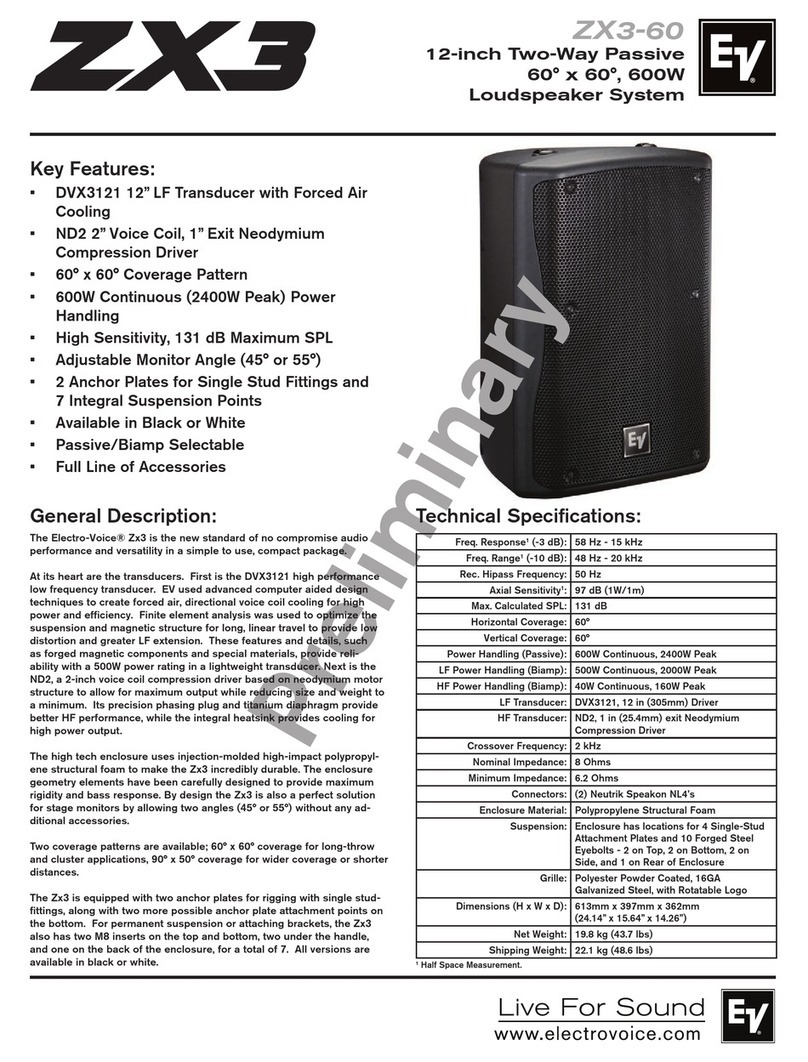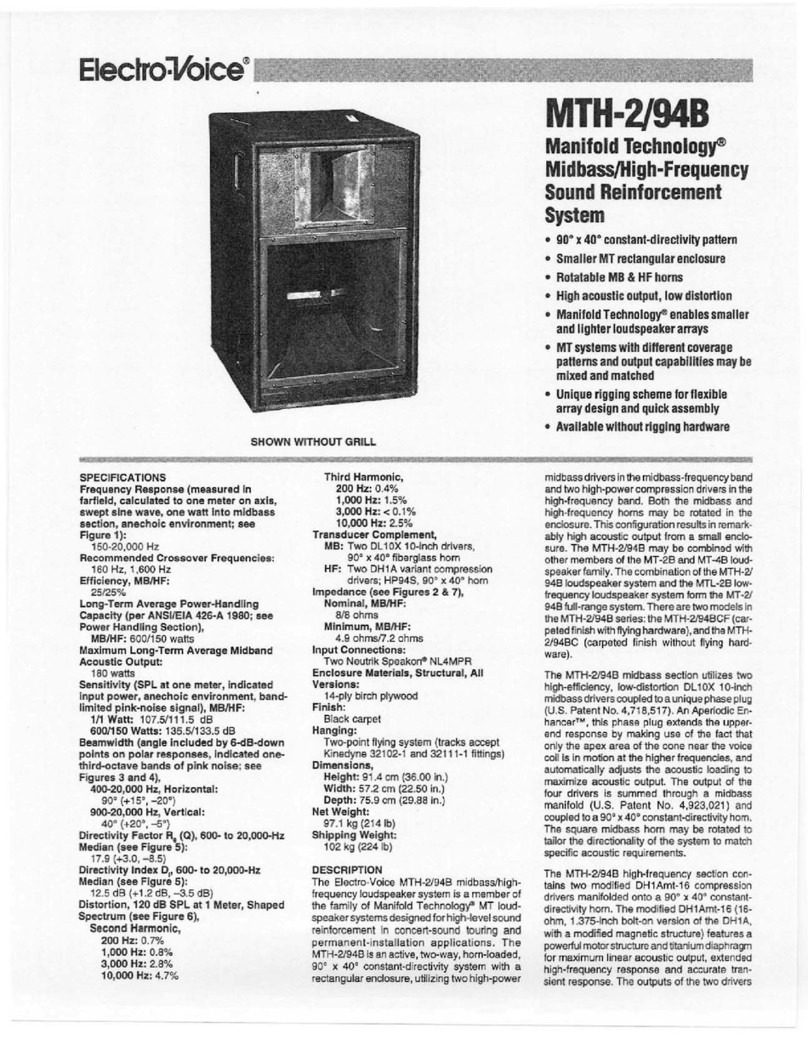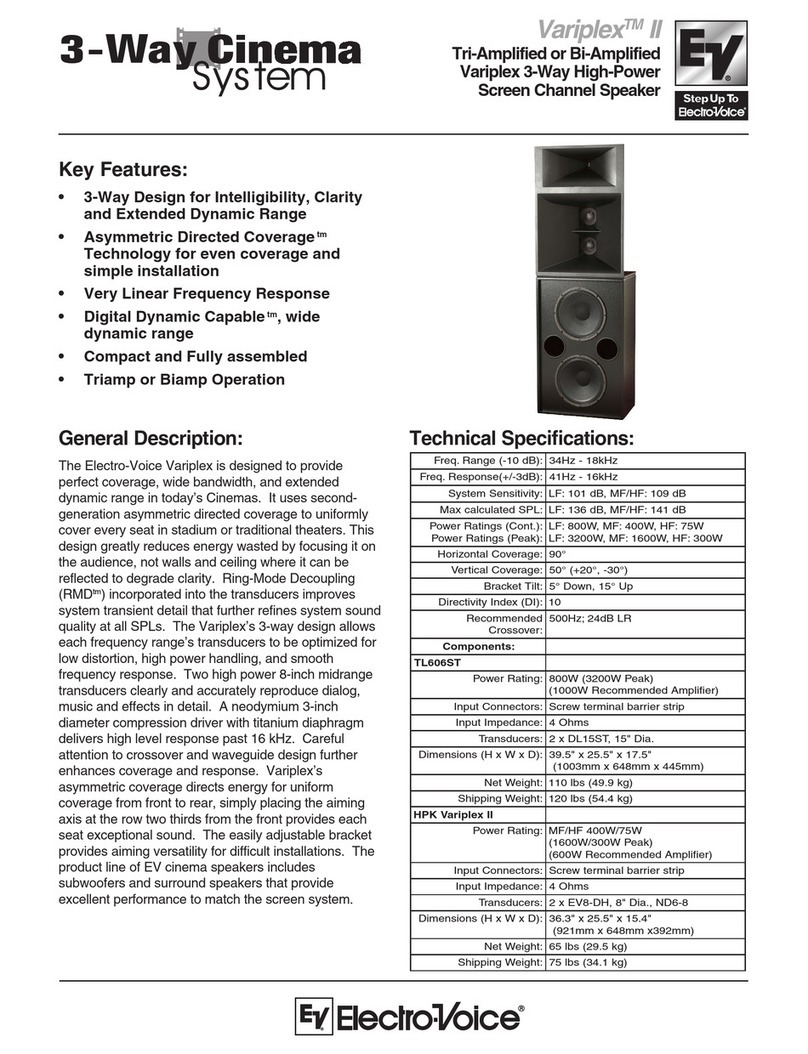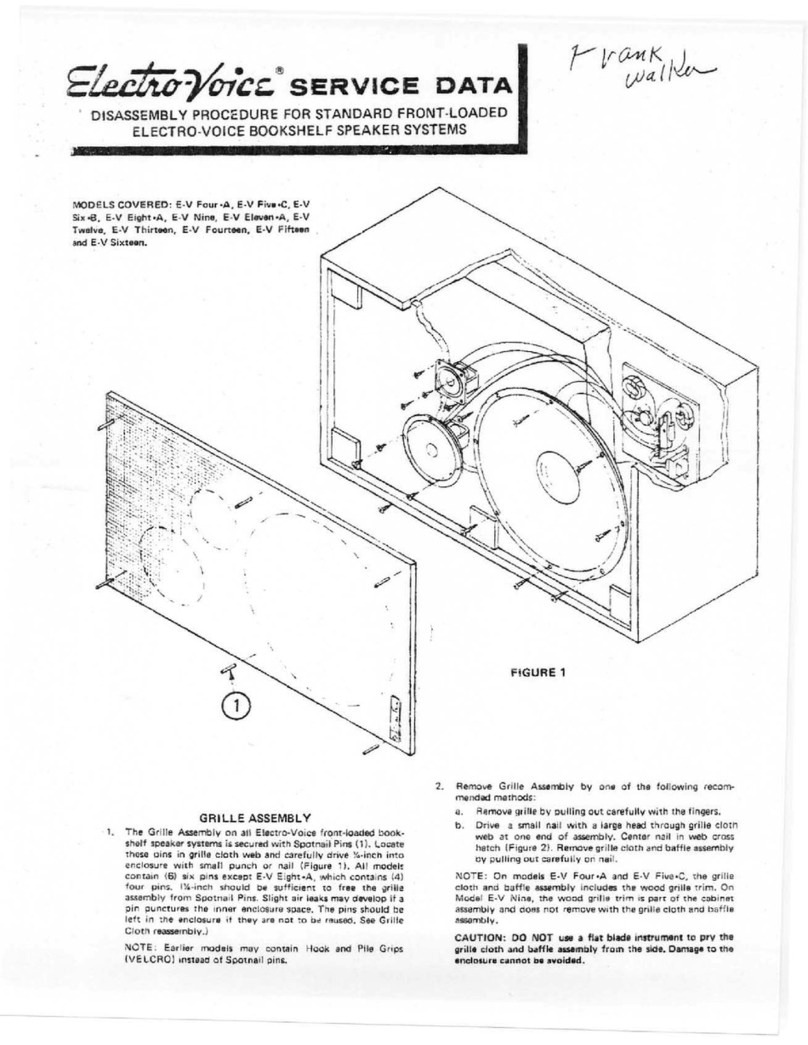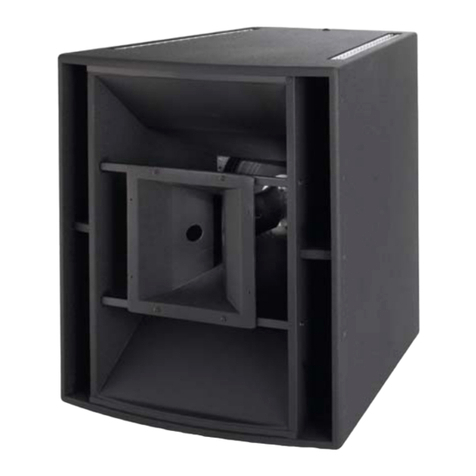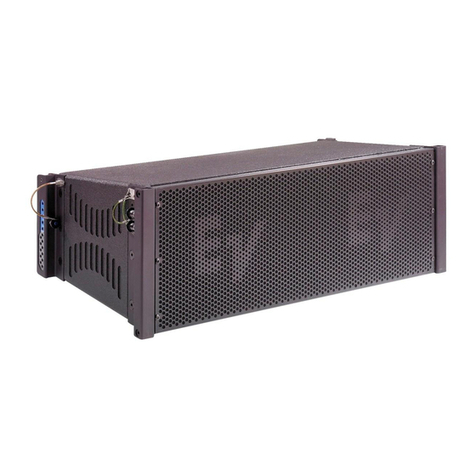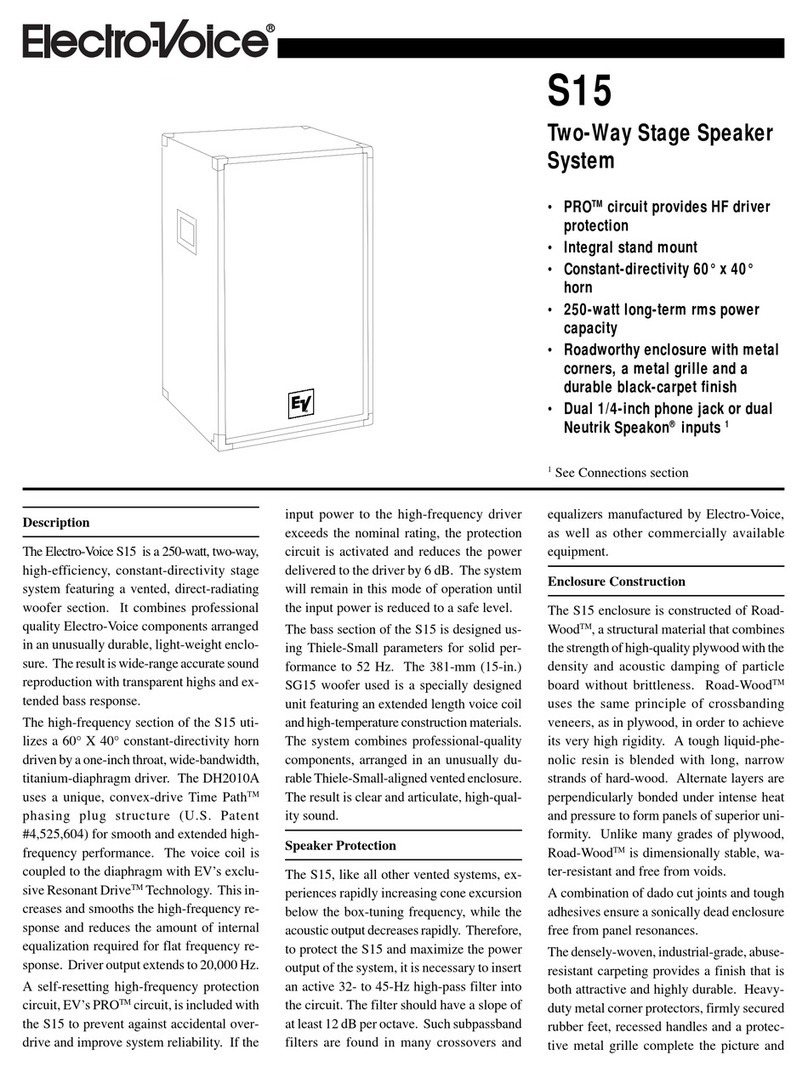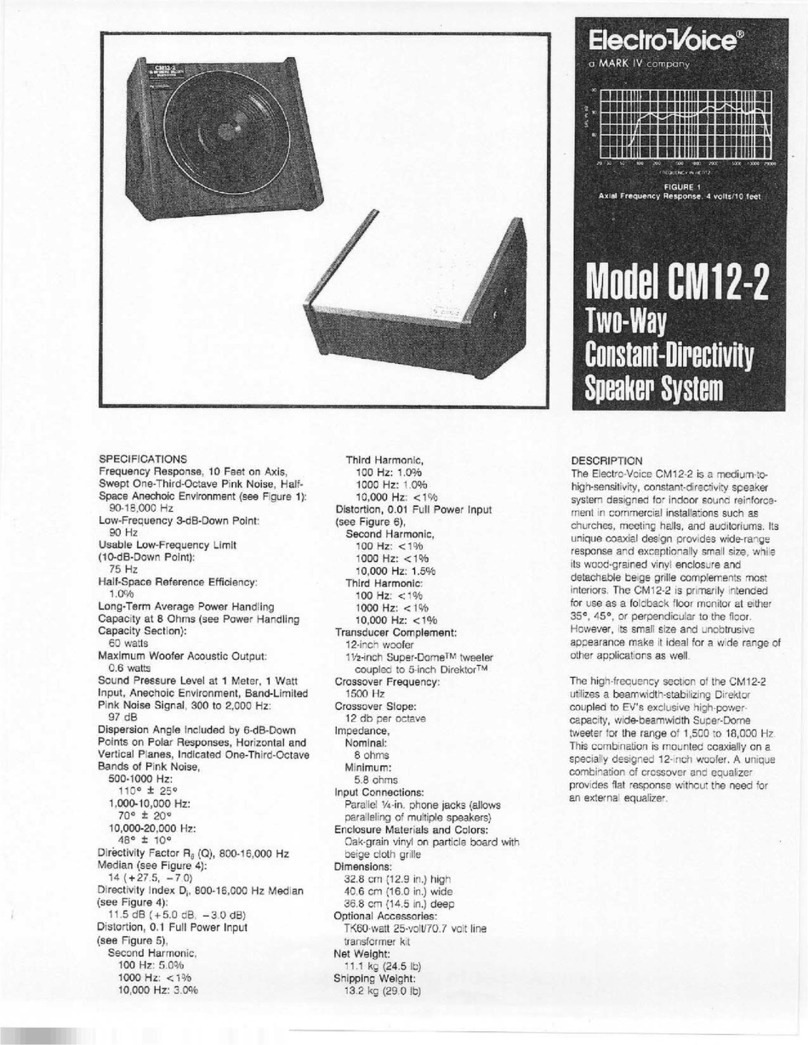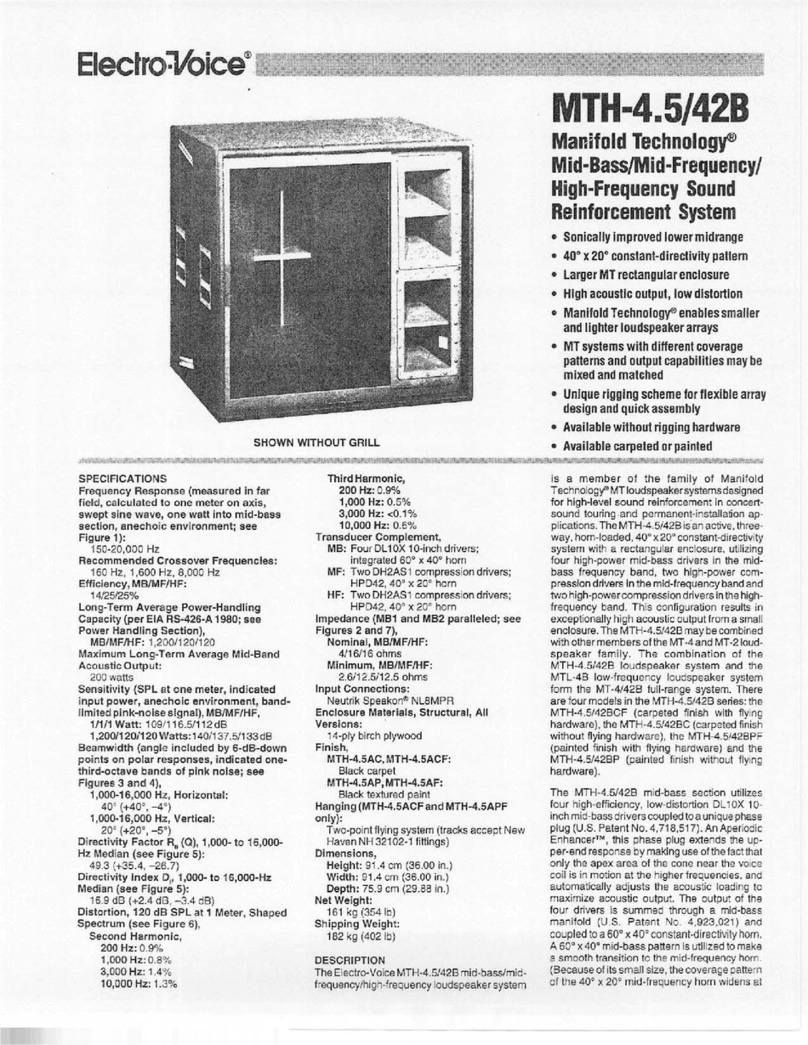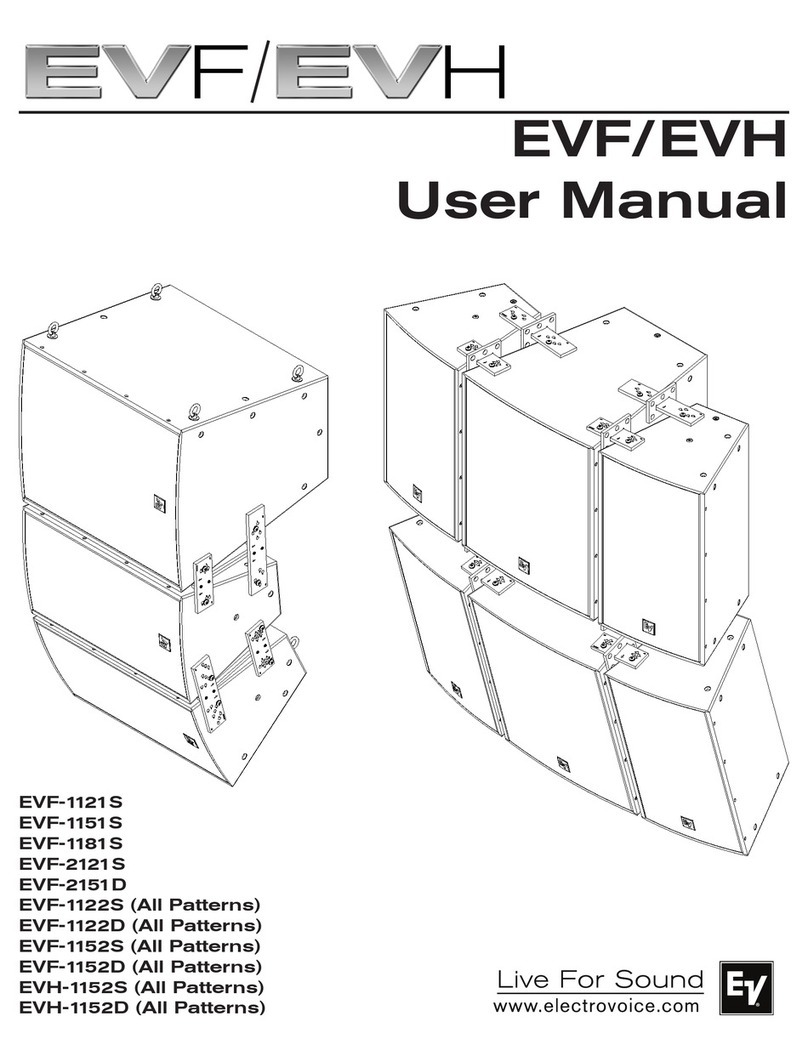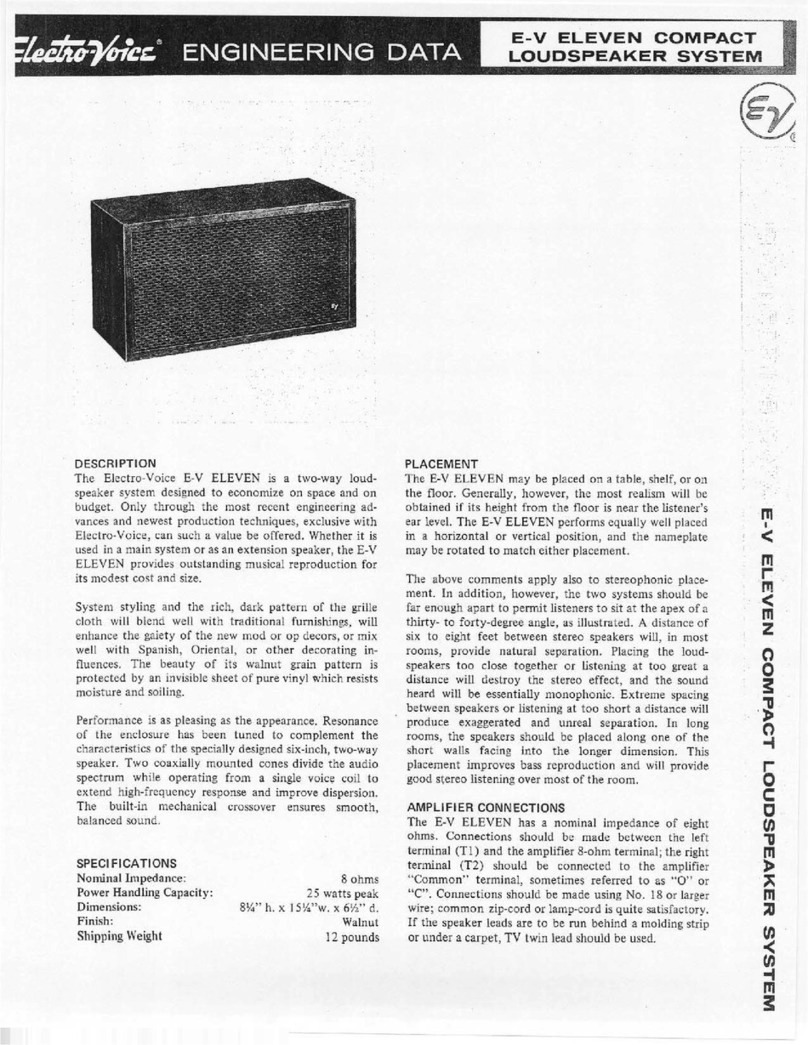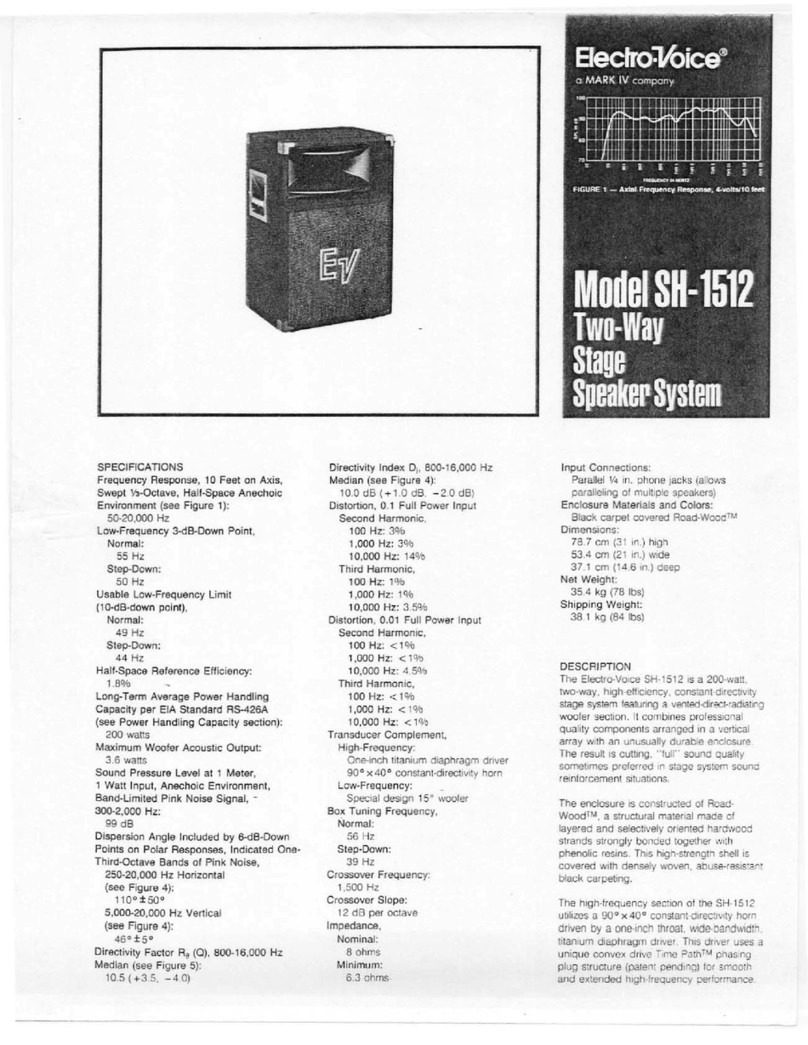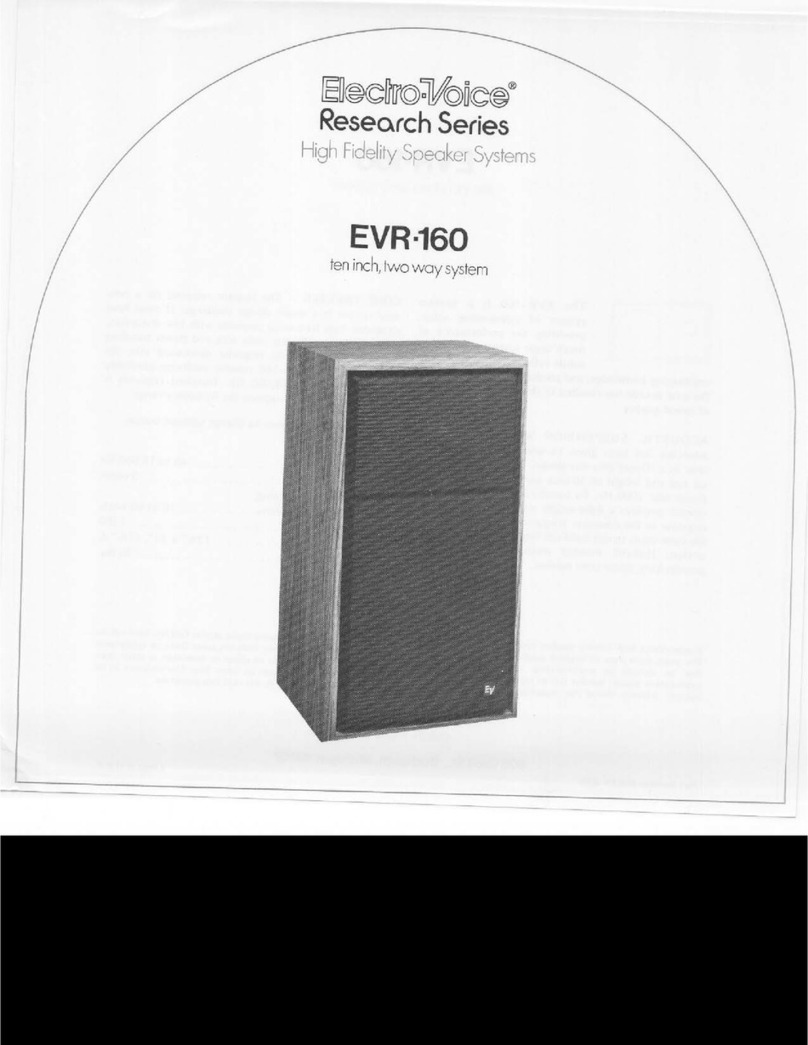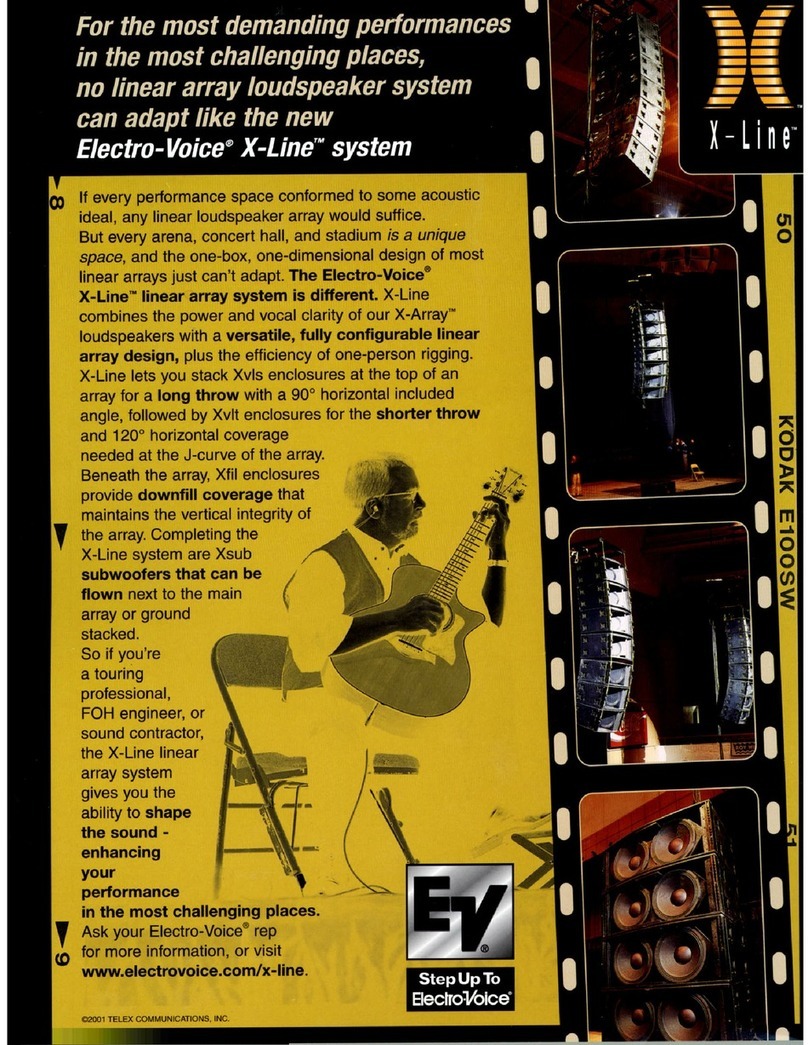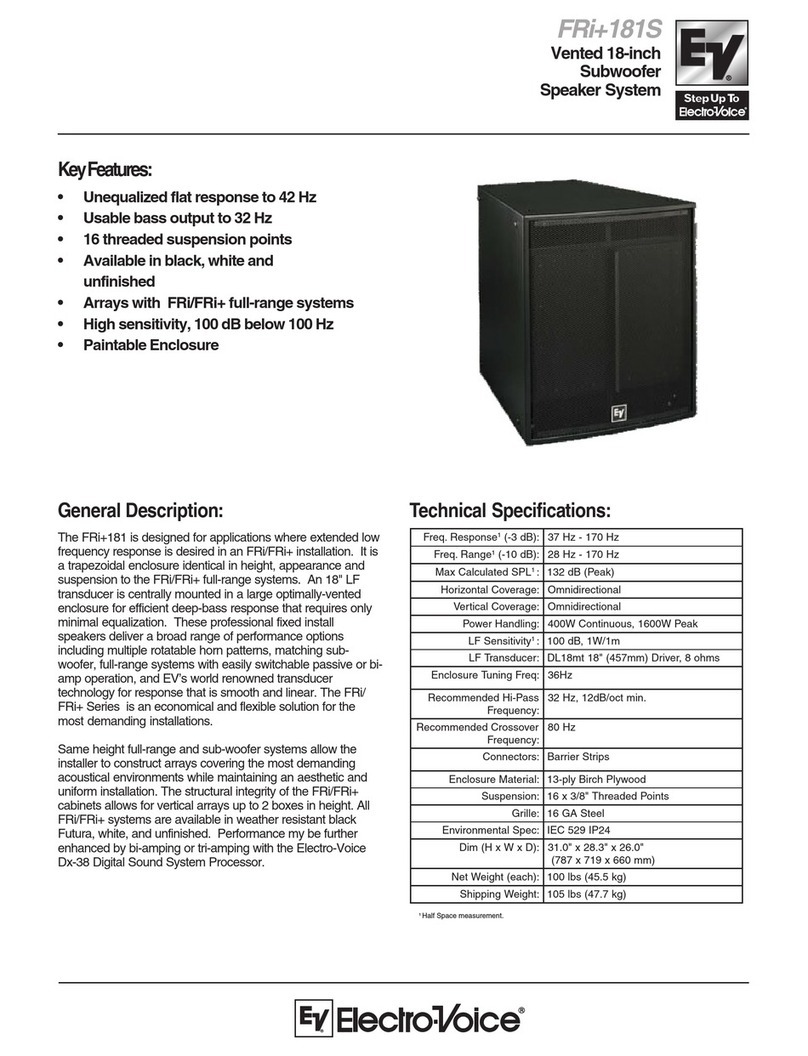
T251i Trapezoidal Speaker System
T251i Trapezoidal Speaker System
3
Power-Handling Capacity
To our knowledge, Electro-Voice was the
first U.S. manufacturer to develop and pub-
lish a power test closely related to real-life
conditions. First, we use a random-noise in-
put signal because it contains many frequen-
cies simultaneously, just like real voice or
instrument program. Second, our signal con-
tains more energy at extremely high and low
frequenciesthantypical actual program, add-
ing an extra measure of reliability. Third, the
testsignal includes not onlythe overall “long
termaverage” or “continuous” level—which
our ears interpret as loudness—but also
short-duration peaks which are many times
higher than the average, just like actual pro-
gram. The long-term average level stresses
the speaker thermally (heat). The instanta-
neouspeaks test mechanicalreliability (cone
anddiaphragmexcursion).Notethatthesine-
wave test signals sometimes used have a
much less demanding peak value relative to
their average level. In actual use, long-term
average levels exist from several seconds on
up, but we apply the long-term average for
several hours, adding another extra measure
of reliability.
Specifically, the T251i is designed to with-
stand the power test described in EIA Stan-
dard RS-426-A 1980. The EIA test spectrum
isapplied for eighthours. To obtain the spec-
trum, the output of a white-noise generator
(white noise is a particular type of random
noisewithequalenergyperbandwidthinHz)
is fed to a shaping filter with 6-dB-per-oc-
tave slopes below 40 Hz and above 318 Hz.
When measured with an analyzer having the
usual constant-percentage bandwidth (one-
third octave), this shaping filter produces a
spectrum whose 3-dB-down points are at
100 Hz and 1,200 Hz with a 3-dB-per-oc-
tave slope above 1,200 Hz. This shaped sig-
nal is sent to the power amplifier with the
continuous power set at 400 watts into the
5.175-ohm EIA equivalent impedance
(45.5 volts true rms). Amplifierclippingsets
instantaneous peaks at 6 dB above the con-
tinuouspower, or 1,600 watts peak (91.0 volts
peak).This procedure providesarigoroustest
of both thermal and mechanical failure
modes.
Architects’ and Engineers’
Specifications
The loudspeaker system shall be a two-way,
full-range design consisting of a 381-mm
(15-inch) woofer in a vented, trapezoidal-
shapedenclosure,ahigh-frequencycompres-
sion driver mounted on a rotatable 60° x 40°
constant-directivityhorn and a passive cross-
over/equalizer network. The loudspeaker
shall meet the following performance crite-
ria: frequency response of 50-16,000 Hz,
–3dB; power handling of 400 watts long
term and 1,600 watts short term with a
shaped random-noise input per EIA
Standard RS-426-A 1980;sensitivityof101
dB SPL at 1 meter with a 1-watt, 300-2,000-Hz
pink-noise input; 6-dB-down horizontal cover-
age angle of 60° ±10° in the 2,500-20,000-Hz
range; 6-dB-down vertical coverage angle of
40°±4° in the 3,150-16,000-Hz range;cross-
over frequency of 2,200 Hz; nominal imped-
ance of 8 ohms; and minimum impedance of
5.9 ohms. Input connections shall be two
paralleledNeutrik Speakon®connectors.The
enclosure shall be constructed of 13-ply
void-freeplywood, covered with a whitetex-
tured paint with a black steel grille. Hard-
ware required to suspend the system over-
head will be preinstalled. Suspension will
be accomplished by a total of three 3/8-in.
eyebolts (included). Two are mounted to the
topof the enclosure and one inthe back panel
for aiming purposes. Dimensions shall be
822 mm (32.35 in.) high x 476 mm (18.75 in.)
wide at front x 272 mm (10.71 in.) wide at
rear x 591 mm (23.25 in.) deep. Net weight
shall be 35.5 kg (78 lb), estimated.
The loudspeaker system shall be the
Electro-Voice T251i.
Limited Warranty
Electro-Voice products are guaranteed
against malfunction due to defects in mate-
rials or workmanship for a specified period,
as noted in the individual product-line
statement(s)below,or in the individualprod-
uct data sheet or owner’s manual, beginning
with the date of original purchase. If such
malfunction occurs during the specified pe-
riod, the product will be repaired or replaced
(at our option) without charge. The product
will be returned to the customer prepaid.
Exclusions and Limitations: The Limited
Warranty does not apply to: (a) exterior fin-
ish or appearance; (b) certain specific items
described in the individual product-line
statement(s)below,or in the individualprod-
uct data sheet or owner’s manual; (c) mal-
function resulting from use or operation of
the product other than as specified in the
product data sheet or owner’s manual; (d)
malfunction resulting from misuse or abuse
of the product; or (e) malfunction occurring
at any time after repairs have been made to
theproductbyanyoneotherthanElectro-Voice
orany ofitsauthorizedservice representatives.
Obtaining Warranty Service: To obtain war-
ranty service, a customer must deliver the
product, prepaid, to Electro-Voice or any of
its authorized service representatives to-
gether with proof of purchase of the product
in the form of a bill of sale or receipted in-
voice. A list of authorized service repre-
sentatives is available from Electro-Voice
at 600 Cecil Street, Buchanan, MI 49107
(616/695-6831 or 800/234-6831) and/or
Electro-Voice West, at 8234 Doe Avenue,
Visalia, CA 93291 (209/651-7777 or
800/825-1242). IncidentalandConsequen-
tialDamages Excluded: Productrepair or re-
placement and return to the customer are the
only remedies provided to the customer.
Electro-Voice shall not be liable for any in-
cidentalorconsequential damages including,
without limitation, injury to persons or prop-
erty or loss of use. Some states do not allow
the exclusion or limitation of incidental or
consequential damages so the above limita-
tionor exclusion may not apply toyou. Other
Rights: This warranty gives you specific le-
galrights, and you may alsohave other rights
which vary from state to state.
Electro-Voice Speakers and Speaker Systems
are guaranteed against malfunction due to
defects in materials or workmanship for a
periodof five (5) years from thedate of origi-
nal purchase. The Limited Warranty does
notapply to burned voice coils. Electro-Voice
active electronics associated with the speaker
systemsare guaranteedforthree (3)yearsfrom
the date of original purchase. Additional de-
tails are included in the Uniform Limited
Warranty statement.
Service and repair address for this product:
Electro-Voice, Inc., 600 Cecil Street, Bucha-
nan, Michigan 49107 (616/695-6831 or
800/234-6831).
Specifications subject to change without
notice.





